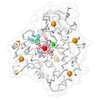[English] 日本語
 Yorodumi
Yorodumi- PDB-5xof: Crystal structure of human paired immunoglobulin-like type 2 rece... -
+ Open data
Open data
- Basic information
Basic information
| Entry | Database: PDB / ID: 5xof | |||||||||
|---|---|---|---|---|---|---|---|---|---|---|
| Title | Crystal structure of human paired immunoglobulin-like type 2 receptor alpha with synthesized glycopeptide I | |||||||||
 Components Components |
| |||||||||
 Keywords Keywords | IMMUNE SYSTEM / membrane protein / immune receptor / viral entry inhibitor / glycopeptide | |||||||||
| Function / homology |  Function and homology information Function and homology informationregulation of the force of heart contraction by chemical signal / NOSIP mediated eNOS trafficking / negative regulation of muscle hyperplasia / tetrahydrobiopterin metabolic process / NOSTRIN mediated eNOS trafficking / smooth muscle hyperplasia / regulation of nervous system process / superoxide-generating NAD(P)H oxidase activity / ovulation from ovarian follicle / pulmonary valve morphogenesis ...regulation of the force of heart contraction by chemical signal / NOSIP mediated eNOS trafficking / negative regulation of muscle hyperplasia / tetrahydrobiopterin metabolic process / NOSTRIN mediated eNOS trafficking / smooth muscle hyperplasia / regulation of nervous system process / superoxide-generating NAD(P)H oxidase activity / ovulation from ovarian follicle / pulmonary valve morphogenesis / response to fluid shear stress / negative regulation of biomineral tissue development / Nitric oxide stimulates guanylate cyclase / regulation of systemic arterial blood pressure by endothelin / ROS and RNS production in phagocytes / tetrahydrobiopterin binding / arginine binding / aortic valve morphogenesis / endocardial cushion morphogenesis / ventricular septum morphogenesis / positive regulation of Notch signaling pathway / cadmium ion binding / negative regulation of calcium ion transport / negative regulation of potassium ion transport / MHC class I protein binding / negative regulation of platelet activation / actin monomer binding / nitric oxide mediated signal transduction / nitric-oxide synthase (NADPH) / blood vessel remodeling / positive regulation of blood vessel endothelial cell migration / nitric-oxide synthase activity / endothelial cell migration / L-arginine catabolic process / negative regulation of extrinsic apoptotic signaling pathway via death domain receptors / regulation of sodium ion transport / negative regulation of blood pressure / response to hormone / nitric oxide metabolic process / eNOS activation / Tetrahydrobiopterin (BH4) synthesis, recycling, salvage and regulation / nitric oxide biosynthetic process / homeostasis of number of cells within a tissue / removal of superoxide radicals / lung development / cell redox homeostasis / lipopolysaccharide-mediated signaling pathway / blood vessel diameter maintenance / VEGFR2 mediated vascular permeability / mitochondrion organization / negative regulation of smooth muscle cell proliferation / establishment of localization in cell / caveola / potassium ion transport / regulation of blood pressure / vasodilation / positive regulation of angiogenesis / Immunoregulatory interactions between a Lymphoid and a non-Lymphoid cell / endocytic vesicle membrane / calcium ion transport / FMN binding / NADP binding / flavin adenine dinucleotide binding / response to heat / scaffold protein binding / High laminar flow shear stress activates signaling by PIEZO1 and PECAM1:CDH5:KDR in endothelial cells / angiogenesis / response to lipopolysaccharide / in utero embryonic development / cytoskeleton / calmodulin binding / Extra-nuclear estrogen signaling / Golgi membrane / negative regulation of cell population proliferation / heme binding / positive regulation of gene expression / Golgi apparatus / signal transduction / extracellular exosome / nucleus / plasma membrane / cytoplasm / cytosol Similarity search - Function | |||||||||
| Biological species |  Homo sapiens (human) Homo sapiens (human) | |||||||||
| Method |  X-RAY DIFFRACTION / X-RAY DIFFRACTION /  SYNCHROTRON / SYNCHROTRON /  MOLECULAR REPLACEMENT / Resolution: 1.963 Å MOLECULAR REPLACEMENT / Resolution: 1.963 Å | |||||||||
 Authors Authors | Furukawa, A. / Kakita, K. / Yamada, T. / Ishizuka, M. / Sakamoto, J. / Hatori, N. / Maeda, N. / Ohsaka, F. / Saitoh, T. / Nomura, T. ...Furukawa, A. / Kakita, K. / Yamada, T. / Ishizuka, M. / Sakamoto, J. / Hatori, N. / Maeda, N. / Ohsaka, F. / Saitoh, T. / Nomura, T. / Kuroki, K. / Nambu, H. / Arase, H. / Matsunaga, H. / Anada, M. / Ose, T. / Hashimoto, S. / Maenaka, K. | |||||||||
 Citation Citation |  Journal: J. Biol. Chem. / Year: 2017 Journal: J. Biol. Chem. / Year: 2017Title: Structural and thermodynamic analyses reveal critical features of glycopeptide recognition by the human PILR alpha immune cell receptor. Authors: Furukawa, A. / Kakita, K. / Yamada, T. / Ishizuka, M. / Sakamoto, J. / Hatori, N. / Maeda, N. / Ohsaka, F. / Saitoh, T. / Nomura, T. / Kuroki, K. / Nambu, H. / Arase, H. / Matsunaga, S. / ...Authors: Furukawa, A. / Kakita, K. / Yamada, T. / Ishizuka, M. / Sakamoto, J. / Hatori, N. / Maeda, N. / Ohsaka, F. / Saitoh, T. / Nomura, T. / Kuroki, K. / Nambu, H. / Arase, H. / Matsunaga, S. / Anada, M. / Ose, T. / Hashimoto, S. / Maenaka, K. | |||||||||
| History |
|
- Structure visualization
Structure visualization
| Structure viewer | Molecule:  Molmil Molmil Jmol/JSmol Jmol/JSmol |
|---|
- Downloads & links
Downloads & links
- Download
Download
| PDBx/mmCIF format |  5xof.cif.gz 5xof.cif.gz | 122.9 KB | Display |  PDBx/mmCIF format PDBx/mmCIF format |
|---|---|---|---|---|
| PDB format |  pdb5xof.ent.gz pdb5xof.ent.gz | 94.5 KB | Display |  PDB format PDB format |
| PDBx/mmJSON format |  5xof.json.gz 5xof.json.gz | Tree view |  PDBx/mmJSON format PDBx/mmJSON format | |
| Others |  Other downloads Other downloads |
-Validation report
| Arichive directory |  https://data.pdbj.org/pub/pdb/validation_reports/xo/5xof https://data.pdbj.org/pub/pdb/validation_reports/xo/5xof ftp://data.pdbj.org/pub/pdb/validation_reports/xo/5xof ftp://data.pdbj.org/pub/pdb/validation_reports/xo/5xof | HTTPS FTP |
|---|
-Related structure data
| Related structure data |  5xo2C 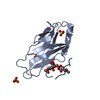 3wv0S S: Starting model for refinement C: citing same article ( |
|---|---|
| Similar structure data |
- Links
Links
- Assembly
Assembly
| Deposited unit | 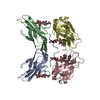
| ||||||||
|---|---|---|---|---|---|---|---|---|---|
| 1 | 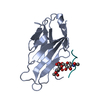
| ||||||||
| 2 | 
| ||||||||
| 3 | 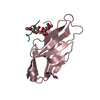
| ||||||||
| 4 | 
| ||||||||
| Unit cell |
|
- Components
Components
| #1: Protein | Mass: 13967.697 Da / Num. of mol.: 4 / Fragment: UNP residues 32-150 Source method: isolated from a genetically manipulated source Source: (gene. exp.)  Homo sapiens (human) / Gene: PILRA / Production host: Homo sapiens (human) / Gene: PILRA / Production host:  #2: Protein/peptide | Mass: 609.671 Da / Num. of mol.: 4 / Source method: obtained synthetically / Source: (synth.)  Homo sapiens (human) / References: UniProt: P29474, nitric-oxide synthase (NADPH) Homo sapiens (human) / References: UniProt: P29474, nitric-oxide synthase (NADPH)#3: Polysaccharide | N-acetyl-alpha-neuraminic acid-(2-6)-2-acetamido-2-deoxy-alpha-D-glucopyranose Source method: isolated from a genetically manipulated source #4: Water | ChemComp-HOH / | Has protein modification | Y | |
|---|
-Experimental details
-Experiment
| Experiment | Method:  X-RAY DIFFRACTION / Number of used crystals: 1 X-RAY DIFFRACTION / Number of used crystals: 1 |
|---|
- Sample preparation
Sample preparation
| Crystal | Density Matthews: 2.2 Å3/Da / Density % sol: 44.18 % |
|---|---|
| Crystal grow | Temperature: 293 K / Method: vapor diffusion, sitting drop / Details: 0.1M Tris-HCl pH8.5, 25% (w/v) PEG 6000 |
-Data collection
| Diffraction | Mean temperature: 100 K |
|---|---|
| Diffraction source | Source:  SYNCHROTRON / Site: SYNCHROTRON / Site:  SPring-8 SPring-8  / Beamline: BL44XU / Wavelength: 1 Å / Beamline: BL44XU / Wavelength: 1 Å |
| Detector | Type: Bruker DIP-6040 / Detector: CCD / Date: Oct 25, 2014 |
| Radiation | Protocol: SINGLE WAVELENGTH / Monochromatic (M) / Laue (L): M / Scattering type: x-ray |
| Radiation wavelength | Wavelength: 1 Å / Relative weight: 1 |
| Reflection | Resolution: 1.96→50 Å / Num. obs: 36271 / % possible obs: 99.4 % / Redundancy: 3.8 % / Rmerge(I) obs: 0.105 / Net I/σ(I): 20.9 |
| Reflection shell | Resolution: 1.96→1.99 Å / Redundancy: 3.8 % / Rmerge(I) obs: 0.322 / Mean I/σ(I) obs: 5.5 / Num. unique all: 1754 / % possible all: 96.35 |
- Processing
Processing
| Software |
| ||||||||||||||||
|---|---|---|---|---|---|---|---|---|---|---|---|---|---|---|---|---|---|
| Refinement | Method to determine structure:  MOLECULAR REPLACEMENT MOLECULAR REPLACEMENTStarting model: 3WV0 Resolution: 1.963→40.05 Å / Cross valid method: FREE R-VALUE
| ||||||||||||||||
| Refinement step | Cycle: LAST / Resolution: 1.963→40.05 Å
| ||||||||||||||||
| LS refinement shell | Resolution: 1.963→2.033 Å
|
 Movie
Movie Controller
Controller




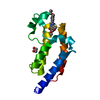
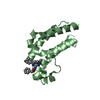
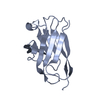
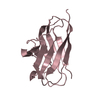
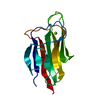

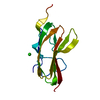

 PDBj
PDBj
